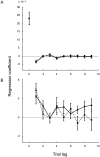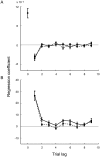Suboptimal Criterion Learning in Static and Dynamic Environments
- PMID: 28046006
- PMCID: PMC5242548
- DOI: 10.1371/journal.pcbi.1005304
Suboptimal Criterion Learning in Static and Dynamic Environments
Abstract
Humans often make decisions based on uncertain sensory information. Signal detection theory (SDT) describes detection and discrimination decisions as a comparison of stimulus "strength" to a fixed decision criterion. However, recent research suggests that current responses depend on the recent history of stimuli and previous responses, suggesting that the decision criterion is updated trial-by-trial. The mechanisms underpinning criterion setting remain unknown. Here, we examine how observers learn to set a decision criterion in an orientation-discrimination task under both static and dynamic conditions. To investigate mechanisms underlying trial-by-trial criterion placement, we introduce a novel task in which participants explicitly set the criterion, and compare it to a more traditional discrimination task, allowing us to model this explicit indication of criterion dynamics. In each task, stimuli were ellipses with principal orientations drawn from two categories: Gaussian distributions with different means and equal variance. In the covert-criterion task, observers categorized a displayed ellipse. In the overt-criterion task, observers adjusted the orientation of a line that served as the discrimination criterion for a subsequently presented ellipse. We compared performance to the ideal Bayesian learner and several suboptimal models that varied in both computational and memory demands. Under static and dynamic conditions, we found that, in both tasks, observers used suboptimal learning rules. In most conditions, a model in which the recent history of past samples determines a belief about category means fit the data best for most observers and on average. Our results reveal dynamic adjustment of discrimination criterion, even after prolonged training, and indicate how decision criteria are updated over time.
Conflict of interest statement
The authors have declared that no competing interests exist.
Figures










Similar articles
-
Stimulus uncertainty and relative reward rates determine adaptive responding in perceptual decision-making.PLoS Comput Biol. 2025 May 27;21(5):e1012636. doi: 10.1371/journal.pcbi.1012636. eCollection 2025 May. PLoS Comput Biol. 2025. PMID: 40424292 Free PMC article.
-
Decision criteria in dual discrimination tasks estimated using external-noise methods.Atten Percept Psychophys. 2012 Jul;74(5):1042-55. doi: 10.3758/s13414-012-0269-0. Atten Percept Psychophys. 2012. PMID: 22351481
-
A dynamic stimulus-driven model of signal detection.Psychol Rev. 2011 Oct;118(4):583-613. doi: 10.1037/a0025191. Psychol Rev. 2011. PMID: 21895383
-
Visual Decision-Making in an Uncertain and Dynamic World.Annu Rev Vis Sci. 2017 Sep 15;3:227-250. doi: 10.1146/annurev-vision-111815-114511. Epub 2017 Jul 17. Annu Rev Vis Sci. 2017. PMID: 28715956 Review.
-
Reward-dependent learning in neuronal networks for planning and decision making.Prog Brain Res. 2000;126:217-29. doi: 10.1016/S0079-6123(00)26016-0. Prog Brain Res. 2000. PMID: 11105649 Review.
Cited by
-
Forget-me-some: General versus special purpose models in a hierarchical probabilistic task.PLoS One. 2018 Oct 22;13(10):e0205974. doi: 10.1371/journal.pone.0205974. eCollection 2018. PLoS One. 2018. PMID: 30346977 Free PMC article. Clinical Trial.
-
An Infrastructure Framework for Remote Patient Monitoring Interventions and Research.J Med Internet Res. 2024 May 30;26:e51234. doi: 10.2196/51234. J Med Internet Res. 2024. PMID: 38815263 Free PMC article.
-
Boundary updating as a source of history effect on decision uncertainty.iScience. 2023 Oct 28;26(11):108314. doi: 10.1016/j.isci.2023.108314. eCollection 2023 Nov 17. iScience. 2023. PMID: 38026228 Free PMC article.
-
Counterfactual Reasoning Underlies the Learning of Priors in Decision Making.Neuron. 2018 Sep 5;99(5):1083-1097.e6. doi: 10.1016/j.neuron.2018.07.035. Epub 2018 Aug 16. Neuron. 2018. PMID: 30122376 Free PMC article.
-
Human online adaptation to changes in prior probability.PLoS Comput Biol. 2019 Jul 8;15(7):e1006681. doi: 10.1371/journal.pcbi.1006681. eCollection 2019 Jul. PLoS Comput Biol. 2019. PMID: 31283765 Free PMC article.
References
-
- Green D.M., Swets J.A. (1966). Signal detection theory and psychophysics. New York: Wiley.
-
- Healy A.F., Kubovy M. (1981). Probability matching and the formation of conservative decision rules in a numerical analog of signal detection. J Exp Psychol Hum Learn 7, 344–354.
-
- Tanner W.P., Swets J.A., Green D.M. (1956). Some general properties of the hearing mechanism. Technical Report 30, Electronic Defense Group: University of Michigan.
Publication types
MeSH terms
Grants and funding
LinkOut - more resources
Full Text Sources
Other Literature Sources
Miscellaneous

